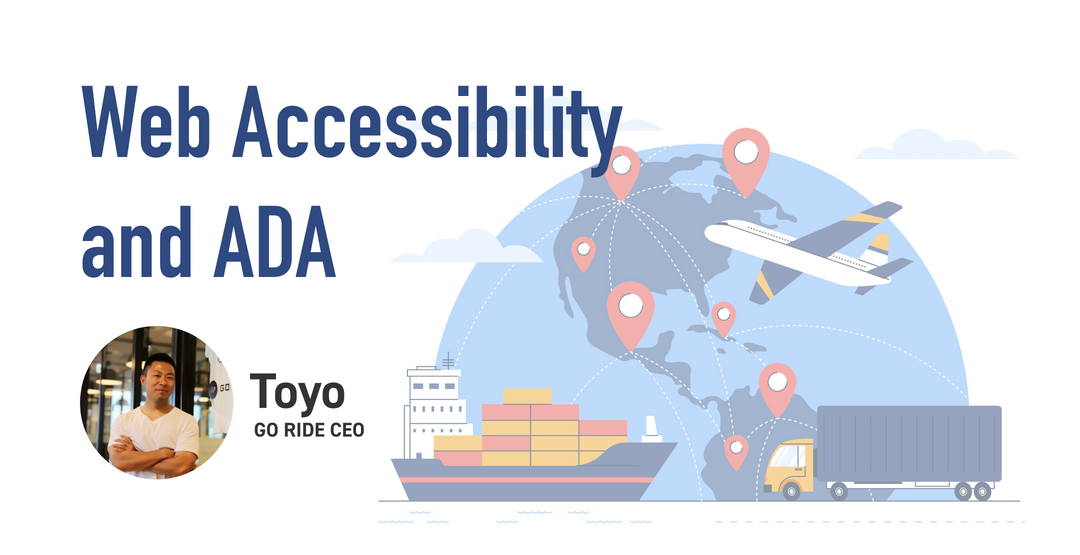Differences between web accessibility and ADA (Americans with Disability Act) that began in Japan
Web accessibility compliance has started in Japan as well.
Until now, GO RIDE has explained the ADA (Americans with Disabilities Act) when operating cross-border EC and EC sites in America.
Past articles are here.
Is it no longer just the era of mouse operations? What you should consider now for ADA compliance
Key points to watch out for in cross-border EC for the U.S.: Tariffs, ADA, CCPA
As of April 1, 2024, Japan will also begin implementing web accessibility measures. The amended Act for Eliminating Discrimination against Persons with Disabilities now requires private companies to provide "reasonable accommodation."
As a result, private businesses will be required to ensure accessibility across all of their websites.
Personally, I dislike the top-down tone of the so-called Anti-Discrimination Act, but I feel that the term "accessibility" is based on the idea of providing equal access to everyone.
Now, I would like to take a closer look at the current trends in Japan's legal reforms, and what measures are necessary, including a comparison with the situation in the United States.
I actually had the opportunity to observe a person with visual impairment using a screen reader to browse the web, and seeing this firsthand made me truly realize the importance and necessity of accessibility. From now on, let's continue to learn about accessibility as it becomes increasingly relevant to our daily lives.
1. What is accessibility?
Web accessibility refers to a state in which websites are accessible and understandable for all users, allowing everyone to use them effectively.
A typical example refers to a situation where people with visual impairments, often called "readers," use devices to access and utilize content. Ideally, however, the goal is to create a state where anyone—including those with hearing impairments or seniors—can access, understand, and use web content without any issues.
Web accessibility aims to ensure that all users—not just people with visual impairments but also seniors whose vision or hearing may be declining—can access content without barriers.
Reference Source: What is Web Accessibility? An Easy-to-Understand Explanation from Zero!

Here, let’s look at a few examples from the Japanese Government Public Relations Office website.
Examples targeting people with visual impairments (including those with weak vision but not classified as disabled)
1. When adding color to text or embedding text in images, ensure there is a high contrast ratio between the text and its background color.

2. Make it possible to operate everything using only the keyboard. Also, ensure that the area currently in focus is easy to identify when using the keyboard.

Examples for people with hearing impairments
1. Add subtitles to video content.

These are just a few examples. For more details, please refer to the Digital Agency's “Introduction to Web Accessibility Guidebook”.
2. Why is there so much focus on accessibility?
In Japan, with the enforcement of the “reasonable accommodation” requirement starting April 1, 2024, addressing web accessibility will not become mandatory. Under the current legal revision, it remains a best-effort obligation, and there are no legal penalties imposed.
Reference: Cabinet Office
Leaflet: “From April 1, 2024, the provision of reasonable accommodation becomes mandatory!”
| Before the revision | After the revision: From April 1, 2024 |
| Endeavor to provide reasonable accommodation | Must provide reasonable accommodation |
| Best-effort obligation | Legal obligation |
In the US, there are explicit penalties and fines (as of February 2024, $4,000 in California), and in Europe, even stricter measures will be implemented in 2025.
European Accessibility Act 2025
It is expected to move forward in this direction, and the number of lawsuits, including those filed by individuals, is showing a significant upward trend.
Website accessibility has been a part of the ADA since the early 2000s and related lawsuits have increased significantly in recent years. The website accessibility lawsuit forecast for 2023 is pointing at 4,220 lawsuits — 185 more than the year before and almost twice as many as in 2018.
In major developed countries, efforts are progressing toward creating a more inclusive society beyond just equal opportunity, and it is expected that Japan will also take more concrete steps in this direction.
3. Differences between Japan, the U.S. ADA, and the European Accessibility Act 2025
| America | Europe | Japan | |
| Penalties | Yes $20,000 - $75,000 for the first violation | Still unknown for EAA2025 | No, best-effort obligation |
| Name | ADA (Americans with Disabilities Act) | EAA 2025 (European Accessibility Act) | Act for Eliminating Discrimination against Persons with Disabilities |
The details of the penalties for EAA 2025 are still unclear, but considering that the current GDPR penalty can be up to 20 million euros or 4% of global annual turnover, whichever is higher, it is widely expected that the fines will not be small.
For EAA 2025, companies have until June 2025 to comply, so it is necessary to start preparing now.
EC sites are also subject to these regulations.
Reference: The European Accessibility Act: Empowering Inclusion in Digital Environments
4. What is reasonable accommodation?
Reasonable accommodation refers to making adjustments to the environment (for example, as mentioned above, adding subtitles to videos on websites) as a basic measure, and then providing additional, individualized support tailored to the specific circumstances of each person with a disability. For instance, if someone has difficulty making a purchase on an EC site due to text input on the web, an operator can assist by taking orders over the phone.
5. Building a sustainable operational framework for each company
We consider that there are mainly four steps for companies to take.
1. Understanding the current state of your website
2. Formulating policies and measures for accessibility and reasonable accommodation
3. Implementing measures on the web and clarifying alternative access methods
4. Continuously addressing issues by conducting regular accessibility checks and operational reviews
If you have any questions about accessibility in Japan or overseas, especially regarding accessibility on EC sites, please contact GO RIDE .







![[Time-saving x High efficiency] Create the](http://goriderep.com/cdn/shop/articles/notebooklm_b8a61076-7b0b-43a6-9ed9-c22df6a30022.jpg?v=1767760344&width=600)
![[2026 Update] What are DDU and DDP on Shopify? Explaining the differences in customs handling for cross-border e-commerce and how to set it up](http://goriderep.com/cdn/shop/articles/ddp.jpg?v=1767687833&width=600)


